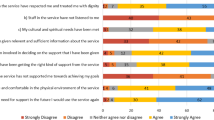Abstract
During clinical recovery mental health consumers express increasing interest in assuming control over their community living arrangements. Despite recent policy initiatives toward consumer empowerment in housing services and supports, few studies have explored empowerment issues, such as self-efficacy, in relation to housing satisfaction. This study explored the extent to which specific areas of support and self-efficacy predict consumer satisfaction with housing. This study also explored how different types of housing, and consumer housing preferences, also explain consumer satisfaction with housing. One-hundred twenty-five randomly selected consumers completed structured interviews. As hypothesized, hierarchical multiple predictor regression analyses revealed type of housing and self-efficacy as significant predictor variables. The total regression equation accounted for 67 percent of the explained variance in housing satisfaction. Chi-square analyses across housing groups indicated that consumers prefer less restrictive residential settings. Findings suggest that consumers prefer less restrictive housing, as such relate in part to increasing levels of self-efficacy. Further study is recommended to explore how self-efficacy may best be promoted across different clinical groups and different residential settings.
Similar content being viewed by others
References
Arns, P.G. & Linney, J.A. (1993). Work, self, and life-satisfaction for persons with severe and persistent mental disorders.Psychosocial Rehabilitation Journal, 17, 63–79.
Bandura, A. (1977). Self-efficacy: toward a unifying theory of behavioral change.Psychological Review, 84, 191–215.
Carling, P.J. (1990). Major mental illness, housing and supports.American Psychologist, 45, 969–975.
Cheng, S.T. (1993). Subjective quality of life in the planning and evaluation of programs.Evaluation and Program Planning, 11, 123–134.
Derogatis, L.R. (1993). Brief symptom inventory: administration, scoring, and procedures manual. Minneapolis: NCS.
Endicott, J., Spitzer, R.L., Fleiss, J.L. & Cohen, J. (1976). The Global Assessment Scale: a procedure for measuring the overall severity of psychiatric disturbance.Archives of General Psychiatry, 33, 776–771.
Goering, P., Paduchak, D. & Durbin, J. (1990). Housing Homeless Women: a consumer preference study.Hospital and Community Psychiatry, 41, 790–794.
Goldstein, J.M., Dziobek, J.F., Clark, R. & Bassuk, E.L. (1990). Supportive housing for the chronically mentally ill.The Journal of Nervous and Mental Disease, 178, 415–422.
Gutek, B.A. (1978). Strategies for studying client satisfaction.Journal of Social Issues, 34, 44–56.
Keck, J. (1990). Responding to consumer housing preferences: the toledo experience.Psychosocial Rehabilitation Journal, 13, 51–58.
Kennedy, L.W., Northcott, H.C. & Kinzel, C. (1978). Subjective evaluation of well-being: Problems and prospects.Social Indicators Research, 5, 457–474.
Keppel, G. (1991).Design and analysis: a researcher's handbook. Englewood Cliffs: Prentice-Hall.
Lehman, A.F. (1983). The well-being of chronic mental patients.Archives of General Psychiatry, 40, 369–373.
Lehman, A.F. (1988). A quality of life interview for the chronically mentally ill.Evaluation and Program Planning, 11, 51–62.
Lehman, A.F. (1991). Quality of life interview: core version, manual.
Lehman, A.F., Ward, N.C. & Linn, L.S. (1982). Chronic mental patients: The quality of life issue.American Journal of Psychiatry, 139, 1271–1276.
Lehman, A.F., Possidente, S.M. & Hawker, F. (1986). The quality of life of chronic patients in a state hospital and in community residences.Hospital and Community Psychiatry, 37, 901–907.
Lehman, A.F., & Burns, B.J. (1990). Severe mental illness in the community. In B. Spilker (Ed.)Quality of Life Assessments in Clinical Trials. New York: Raven.
Lehman, A.F., Slaughter, J.G. & Myers, C.P. (1991). Quality of life in alternative residential settings.Psychiatric Quarterly, 62, 35–49.
Levstek, D.A. & Bond, G.R. (1993). Housing cost, quality, and satisfaction among formerly homeless persons with serious mental illness in two cities.Innovations and Research, 2, 1–8.
Massey, O.T. & Wu, L. (1993). Important characteristics of independent housing for people with mental illness: Perspectives of case managers and consumers.Psychosocial Rehabilitation Journal, 17, 81–92.
National Institute of Mental Health (1987).Toward a model plan for a comprehensive, community-based mental health system. Washington, D.C.: Supt. of Docs., U.S. Govt. Print. Off.
Pearlin, L.I., Lieberman, M., Menaghan, P. & Mullan, J. (1981) The stress process.Journal of Health and Social Behavior, 22, 337–56.
Pinkney, A.A., Gerber, G.J. & LaFave, H.G. (1991). Quality of life after psychiatric rehabilitation: the client's perspective.Acta Psychiatric Scandinavia, 83, 86–91.
Rea, L. & Parker, R. (1992).Designing and Conducting Survey Research: a Comprehensive Guide. San Francisco: Jossey-Bass.
Reich, J.W. & Zautra, A.J. (1983). Demands and desires in daily life: some influences on well-being.American Journal of Community Psychology, 11, 41–58.
Ridgway, P. & Zipple, A.M. (1990). The paradigm shift in residential services: from the linear continuum to supported housing approaches.Psychosocial Rehabilitation Journal, 13, 11–13.
Rosenfield, S. (1992). Factors contributing to the subjective quality of life of the chronic mentally ill.Journal of Health and Social Behavior, 33, 299–315.
Rosenfield, S. & Neese-Todd, S. (1993). Elements of a psychosocial clubhouse program associated with a satisfying quality of life.Hospital and Community Psychiatry, 44, 76–78.
Tanzman, B. (1993). An overview of surveys of mental health consumers' preferences for housing and support services.Hospital and Community Psychiatry, 44, 450–455.
Zautra, A.J. & Reich, J.W. (1983). Life events and perceptions of life quality: developments in a two-factor approach.Journal of Community Psychology, 11, 121–132.
Author information
Authors and Affiliations
Additional information
Thomas A. Seilheimer, Ph.D., is affiliated with St. Clair County Community Mental Health Services, Port Huron, Michigan. Guy T. Doyal, Ph.D., is affiliated with Wayne State University, Detroit, Michigan.
Rights and permissions
About this article
Cite this article
Seilheimer, T.A., Doyal, G.T. Self-efficacy and consumer satisfaction with housing. Community Ment Health J 32, 549–559 (1996). https://doi.org/10.1007/BF02251065
Issue Date:
DOI: https://doi.org/10.1007/BF02251065



